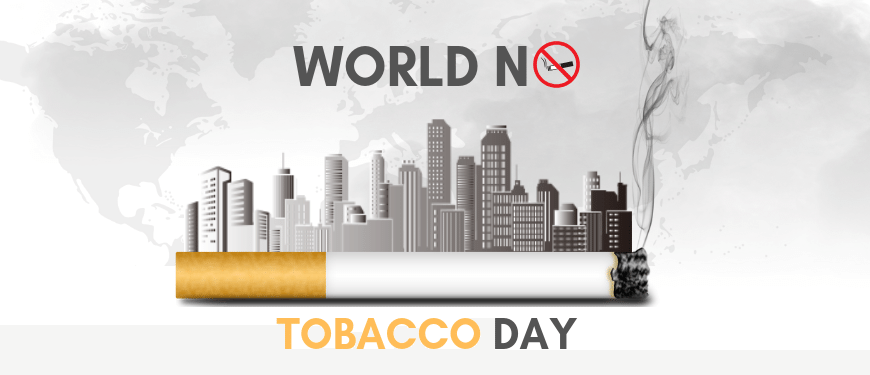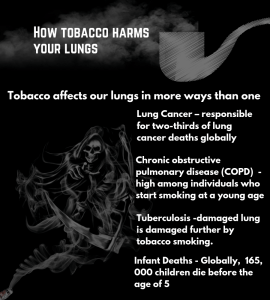World No Tobacco Day 2019

The theme of WNTD 2019 is “Tobacco and Lung Health”

Tobacco Consumption in India
Tobacco consumption in India is one of the biggest menace that India battles among several other. However, 2016-2017 Global Adult Tobacco Survey (GATS) report shows a remarkable reduction of tobacco consumption from 34.6% in 2009-10 to 28.6% in 2016-17. But one cannot afford to relax.
GATS Data:
- The prevalence of current tobacco use among men was 42.4 percent and among women it was 14.2 percent. Every third adult (32.5%) from rural areas and every fifth adult (21.2%) from urban area reported current use of tobacco.
- Among daily cigarette smokers, average cigarette expenditure per month has increased significantly from Rs. 668.04 in GATS 1 to Rs. 1192.45 in GATS 2, after adjusting for inflation.
- The mean number of cigarettes smoked per day by a daily cigarette smoker was 6.8
- Khaini and bidi are the most commonly used tobacco products. However, the prevalance of tobacco use among minors aged 15-17 has decreased from 10% in GATS 1 to 4% in GATS 2.
Health Benefits of Quitting
- Within 2-12 weeks of quitting smoking your circulation improves and your lung function increases.
- 10 years, your risk of lung cancer falls to about half that of a smoker and your risk of cancer of the mouth, throat, esophagus, bladder, cervix, and pancreas decreases.
- 1 year, your risk of coronary heart disease is about half that of a smoker’s.
- Quitting smoking decreases the excess risk of many diseases related to second-hand smoke in children.
How to control Tobacco Consumption
The small silver lining that the GATS report shows has been because of efforts of the government and NGOs working at the grass root level. India was among the first countries to ratify the WHO Framework Convention on Tobacco Control (FCTC) in 2004. Indian enacted comprehensive tobacco control legislation, entitled, “The Cigarette and Other Tobacco Products (Prohibition of Advertisement and Regulation of Trade and Commerce, Production, Supply and Distribution) Act, 2003” (COTPA). Under Section 6 (b) of COTPA, the sale of tobacco products is prohibited in an area within a radius of 100 yards of any educational institutions and mandatory signage in this regard should be displayed prominently near the main gate and on the boundary wall of the school institute.
One of the effective measures of stopping school children and minors from falling prey to tobacco smoking is implementation of vendor licensing through COTPA. The Cigarettes and Other Tobacco Products Act, 2003 (COTPA), specifically prohibits smoking in all public places, prohibition of direct and indirect advertisement, promotion and sponsorship of cigarettes and other tobacco products, prohibition of sale of cigarettes and other tobacco products to minors and within 100 yards of any educational institution, and display of health warning, including pictorial warning on ill effects of tobacco use on the packages of all tobacco products.
Consumer VOICE and Voluntary Health Association of India conducted a Big Tobacco Tiny Targets study to determine the extent of tobacco products being marketed and sold around schools in India. A total sample of 243 schools and 487 points of sale were closely surveyed during this study in these 20 cities.
Through the study, investigators observed 225 points of sale of tobacco products out of the 487 points surveyed around 243 schools in 20 cities across 6 states of India. Street vendors were the most common form of sellers at 56.6% of the 225 tobacco points of sale.

